RUN! Towards Better Health
Running is one of the most efficient, accessible workouts. Hitting a running path (treadmill or road) could just be the key to scoring a healthy heart and a lean body.

As a runner and Track & Field Coach, when I suggest running to my clients it is usually met with a love-it-or-hate-it response. Many of my clients tell me that the only way I would catch them running is if they were being chased. Though there are a few that eagerly accept the challenge and pick a race to hold themselves accountable to.

IT IS TRUE, NOT everyone will love running. However, in COVID-19 times people have found themselves being more willing to adapt and adjust to the things they thought they would never do. Running is one of the most efficient, accessible workouts. Hitting a running path (treadmill or road) could just be the key to scoring a healthy heart and a lean body. Even those that had been avid runners prior to the outbreak were finding themselves hitting the road less often due to shifts in all other areas of life.
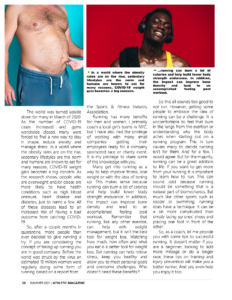
In a world where the obesity rates are on the rise, sedentary lifestyles are the norm and humans are known to eat for many reasons, COVID-19 weight gain becomes a big concern.
The world was turned upside down for many in March of 2020. As the number of COVID-19 cases increased and gyms worldwide closed, many were forced to find a new way to stay in shape, reduce anxiety and manage stress. In a world where the obesity rates are on the rise, sedentary lifestyles are the norm and humans are known to eat for many reasons, COVID-19 weight gain becomes a big concern. As the research shows, people who are overweight and/or obese are more likely to have health conditions such as high blood pressure, heart disease and diabetes, just to name a few. All of these diseases lead to an increased risk of having a bad outcome from catching COVID-19.
So, after a couple months in quarantine, more people than ever decided to give running a try. If you are considering the concept of taking up running you are in good company. Before the world was struck by the virus an estimated 13 million women were regularly doing some form of running based on a report from the Sports & Fitness Industry Association.
Running has many benefits for men and women. I primarily coach a local girl’s teams in NYC, but I have also had the privilege of working with many small companies getting their employees ready for a company sponsored race or charity event. It is my privilege to share some of this knowledge with you.
…running can burn a lot of calories and help build lower body strength endurance. In addition, the impact can improve bone density and lead to an accomplished feeling post workout.
Many get into running as a way to help improve fitness, lose weight or with the idea of toning up. This makes sense because running can burn a lot of calories and help build lower body strength endurance. In addition, the impact can improve bone density and lead to an accomplished feeling post workout. Remember that running, like any other exercise, can help with weight management, but it isn’t the best tool for weight loss. Watching how much, how often and what you eat is a better tool for weight loss. But running can help relieve stress, keep you healthy and allow you to meet personal goals and overcome challenges. Who doesn’t need these benefits?!
So this all sounds too good to not run. However, getting some people to embrace the idea of running can be a challenge. It is uncomfortable to feel that burn in the lungs from the exertion or understanding why the body aches when starting out on a running program. This in turn causes many to decide running isn’t for them. And for a few, I would agree. But for the majority, running can be a great addition to life. If you want to get more from your running it is important to learn how to run. This can sound odd because running should be something that is a natural part of biomechanics. But much like other sports such as soccer or swimming, running does have a technique. It can be a bit more complicated than simply lacing up ones’ shoes and placing one foot in front of the other.
So, as a coach, let me provide you with some tips to successful running. It doesn’t matter if you are a beginner, looking to add more mileage or do a longer race, these tips on training and injury prevention will make you a better runner. And yes, even help you enjoy it too.
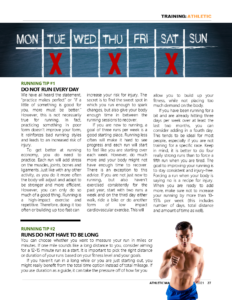
RUNNING TIP #1
DO NOT RUN EVERY DAY
We have all heard the statement, “practice makes perfect” or “if a little of something is good for you, more must be better.” However, this is not necessarily true for running. In fact, practicing something in poor form doesn’t improve your form, it reinforces bad running styles and leads to an increased risk of injury.
To get better at running economy, you do need to practice. Each run will add stress on the muscles, joints, bones and ligaments. Just like with any other activity, as you do it more often the body will adjust and adapt to be stronger and more efficient. However, you can only do so much of a good thing. Running is a high-impact exercise and repetitive. Therefore, doing it too often or building up too fast can increase your risk for injury. The secret is to find the sweet spot in which you run enough to spark changes, but also give your body enough time in between the running sessions to recover.
If you are new to running, a goal of three runs per week is a good starting place. Running less often will make it hard to see progress and each run will start to feel like you are starting over each week. However, do much more and your body might not have enough time to recover. There is an exception to this advice. If you are not just new to running, but also haven’t exercised consistently for the past year, start with two runs a week and on the third day either walk, ride a bike or do another form of low impact cardiovascular exercise. This will allow you to build up your fitness, while not placing too much demand on the body.
If you have been running for a bit and are already hitting three days per week over at least the last two months, you can consider adding in a fourth day. This tends to be ideal for most people, especially if you are not training for a specific race. Keep in mind, it is better to do four really strong runs than to force a fifth run when you are tired. The goal to improving your running is to stay consistent and injury-free. Forcing a run when your body is saying no is a recipe for injury. When you are ready to add more, make sure not to increase your running by more than 10-15% per week (this includes number of days, total distance and amount of time as well).
RUNNING TIP #2
RUNS DO NOT HAVE TO BE LONG
You can choose whether you want to measure your run in miles or minutes. If one mile sounds like a long distance to you, consider aiming for a 12-15 minute run as a start. It is important to pick the right distance or duration of your runs based on your fitness level and your goals.
If you haven’t run in a long while or you are just starting out, you might really benefit from the total time option instead of total mileage. If you use duration as a guide, it can take the pressure off of how far you need to go. This allows you to slow the pace if you need to and still get in your minutes without forcing a distance. An additional benefit is that duration works great when you only have a specific amount of time to get your run in. Whereas with mileage if you get off pace you might not have enough time to complete your planned workout.
Did you know that to get better with your running you do not have to continually increase your mileage and minutes? Once you have found the distance that you are happy with running, maybe it’s 3 or 4 miles three or even four times per week, that is a really good range to maintain fitness. If you want to see better results you can try running the same 3 mile course, but working on doing it slightly faster. Or you can work to cover more distance in the duration goal you have set for yourself. Another way to really boost aerobic and anaerobic fitness is to incorporate intervals into the run you are already comfortable doing. For example, after your first mile, insert one-minute bursts of speed followed by a couple minutes of an easier pace. Aim to add in three or four intervals to start. You can add more as your fitness level improves.
Obviously, if your goal is to complete a half or full marathon you will eventually need to add more mileage. There is no way around that fact. You can do this by making one run a week the long run and adding mileage on to it. Gradually add the mileage, remembering the 10-15% rule and every few weeks pull the mileage back a bit before pushing ahead with more miles. The final recommendation if you are choosing to go the distance running route is to make your long run no longer than half of your weekly total. This will help you stay mindful and not overdue it.
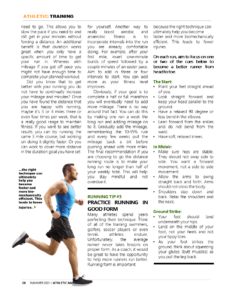
…the right technique can ultimately help you become faster and more bio-mechanically efficient. This leads to fewer injuries.
RUNNING TIP #3
PRACTICE RUNNING IN GOOD FORM
Many athletes spend years perfecting their technique. Think of all of the training swimmers, golfers, soccer players or even tennis athletes endure. Unfortunately, the average runner never takes lessons on proper form. As a coach, it would be great to have the opportunity to help more runners run better. Running form is important because the right technique can ultimately help you become faster and more biomechanically efficient. This leads to fewer injuries.
On each run, aim to focus on one or two of the cues below to become a better runner from head to toe.
The Start:
- Point your feet straight ahead of you.
- Look straight forward and keep your head parallel to the ground.
- Have a relaxed 90 degree or less bend in the elbows.
- Lean forward from the ankles and do not bend from the waist.
- Have soft, relaxed knees.
In Midair:
- Make sure hips are stable. They should not sway side to side. You want a forward movement, not a side to side movement.
- Allow the arms to swing straight back and forth. Arms should not cross the body.
- Shoulders stay down and back. Relax the shoulders and the neck.
Ground Strike:
- Your feet should land underneath your hips.
- Land on the middle of your foot, not your heels and not your tippy toes.
- As your foot strikes the ground, think about squeezing your glutes (butt muscles) as you pull the leg back.
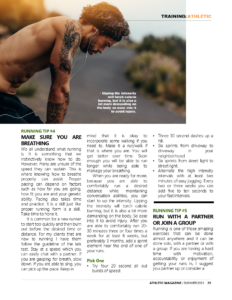
RUNNING TIP #4
MAKE SURE YOU ARE BREATHING
We all understand what running is. It is something that we instinctively know how to do. However, many are unsure of the speed they can sustain. This is where knowing how to breathe properly can assist. Proper pacing can depend on factors such as how far you are going, how fit you are and your genetic ability. Pacing also takes time and practice. It is a skill just like proper running form is a skill. Take time to hone it.
It is common for a new runner to start too quickly and then burn out before the desired time or distance. For my clients that are new to running I have them follow the guideline of the talk test. Stay at a speed which you can easily chat with a partner. If you are gasping for breath, slow down. If you are able to sing, you can pick up the pace. Keep in mind that it is okay to incorporate some walking if you need to. Make it a run/walk if that is where you are. You will get better over time. Soon enough you will be able to run longer while being able to manage your breathing.
When you are ready for more, because you are able to comfortably run a desired distance while maintaining conversation abilities, you can start to up the intensity. Upping the intensity will torch calorie burning, but it is also a lot more demanding on the body. So ease into it to avoid injury. After you are able to comfortably run 20-30 minutes three or four times a week for at least 6 weeks, but preferably 3 months, add a sprint element near the end of one of your runs.
Pick One
- Try four 20 second all out bursts of speed.
- Three 30 second dashes up a hill.
- Six sprints from driveway to driveway in your neighborhood.
- Six sprints from street light to street light.
- Alternate the high intensity intervals with at least two minutes of easy jogging. Every two or three weeks you can add five to ten seconds to your fast intervals.
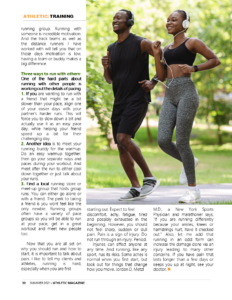
RUNNING TIP #5
RUN WITH A PARTNER OR JOIN A GROUP
Running is one of those amazing exercises that can be done almost anywhere and it can be done solo, with a partner or with a group. If you are having a hard time with motivation, accountability or enjoyment of getting your runs in, I suggest you partner up or consider a running group. Running with someone is incredible motivation. And the track teams as well as the distance runners I have worked with will tell you that on those days motivation is low, having a team or buddy makes a big difference.
THRE WAYS TO RUN WITH OTHERS:
One of the hard parts about running with other people is working out the details of pacing.
- If you are wanting to run with a friend that might be a bit slower than your pace, align one of your easier days with your partner’s harder runs. This will force you to slow down a bit and actually use it as an easy pace day, while helping your friend speed up a bit for their challenging day.
- Another idea is to meet your running buddy for the warmup. Do an easy warmup together, then go your separate ways and paces during your workout. And meet after the run to either cool down together or just talk about your runs.
- Find a local running store or meet-up group that hosts group runs. You can either go alone or with a friend. The perk to taking a friend is you wont feel like the only newbie. Running groups often have a variety of pace groups so you will be able to run at your pace, get in a great workout and meet new people too.
Now that you are all set on why you should run and how to start, it is important to talk about pain. I like to tell my clients and athletes, running is hard, especially when you are first starting out. Expect to feel discomfort, achy, fatigue, tired and possibly exhausted in the beginning. However, you should not feel sharp, sudden or dull pain. Pain is a sign of injury. Do not run through an injury. Period.
Injuries can affect anyone at any time. And running, like any sport, has its risks. Some aches is normal when you first start, but look out for things that change how you move. Jordan D, Metzl M.D., a New York Sports Physician and marathoner says, “If you are running differently because your ankles, knees or hamstrings hurt, have it checked out.” Also, let me add that running in an odd form can increase the damage done via an injury leading to many other concerns. If you have pain that lasts longer than a few days or keeps you up at night, see your doctor.

About the Author:

Kaylin Payne
Kaylin has achieved IPL Pro status in Figure and Women's Athletic. And has earned a Women's Athletic Pro title. She has also competed in the Bikini division. She is the creator and owner of MAXFIT 360, LLC. She has a M.S. in Sport Psychology, is a certified fitness trainer, group exercise instructor and a track and field coach.

ATHLETIC Magazine – Optimism, Confidence, Success: Ten Effective Actions To Build Self-Confidence
These ten practical tips will help you raise the self-esteem you need to achieve your goals and reach your full potential.

ATHLETIC Magazine: 12 Ways To Build A Big Mind
In the realm of fitness and personal development, a strong mindset is just as crucial as physical strength.

ATHLETIC Magazine: How To Be A Fit Man In Your 50s…and Beyond
Being fit in your 50s and beyond is not just about aesthetics. It’s about fostering a healthy lifestyle that enhances your quality of life.

ATHLETIC Magazine – Building A Garage Gym – Part One
In this two-part article series we’ll cover everything you need to know about home gyms. Pros, cons and what equipment you need.

INSPIRE Magazine: How To Find Fun In Every Workout
Finding fun in your fitness routine doesn’t just make the process more enjoyable; it can also enhance your motivation, consistency, and overall results. Here’s how you can infuse fun into every workout, making exercise something to celebrate rather than endure.

ATHLETIC Magazine – Common Fitness Myths
Fitness is an ever-growing industry with so many myths and misconceptions. Let’s have a look!
